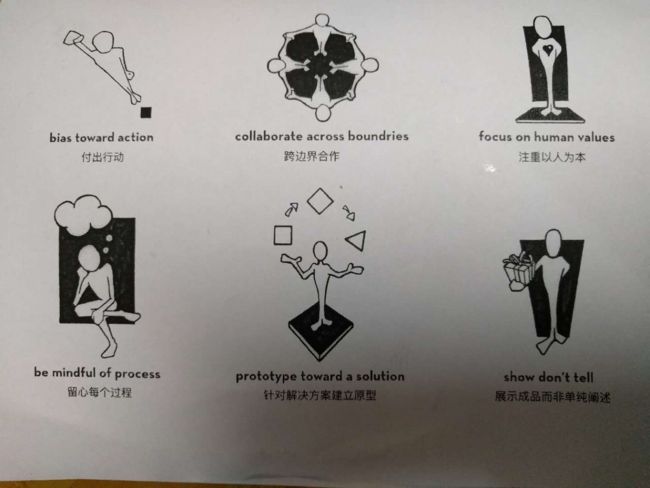Yesterday I went to a workshop p rovided by DesignThinker Group. We’ve tried to solve a problem by thinking like a design. What have impressed me most was a “D” and a “B”.
“D” stands for Deeper, we should always dig deeper about what the customers need.
“B” stands for Better, the concept of “there will be always better solutions” should always stay in our minds.
I’ll show you the processes of how we’ve done it.
昨天我去了一个由DesignThinker's Group组织的工作坊学习如何用设计思维解决问题。最让我印象深刻的主要有两点。
一个是深入,设计思维强调我们必须对用户需要进行深入的挖掘。一个是不断优化,解决方案没有最好,只有更好。
下面介绍整个工作坊的具体过程。
Processes:
Empathize -> Define -> Ideate -> Prototype -> Test
同理心 -> 定义 -> 形成概念 -> 原型 -> 测试
For step 1, empathize, we got this mission: redesign the gift-giving experience…for your partner. Start by gaining empathy.
First, we will need to do a interview about the gift-giving experience. Below are some interview records from me and my partner:
When is the last time of your gift-giving experience? Christmas Eve.
What was it? A necklace.
Who did you give it to? Someone I care about.
Second, we will need to dig deeper about the question. We should now focus more on feelings but not only facts. So we interviewed each other as below:
How did he/she feel after he/she has got the gift?
Out of expectations, surprise, happy.
How did you feel after you have given the gift?
Finishing a task, also happy.
When would you do the gift-giving thing again?
Not planned, maybe just do it when I have to.
第一步,同理心
我们的任务是重新设计“送礼物”的体验,两人一组,互相采访关于送礼物的体验,下面是我们的采访记录。
上一次送礼是什么时候?平安夜。
送了什么?一个项链。
送给谁?一个我在意的人。
然后,我们需要问一些更深入的问题,需要更多地关注送礼过程双方的感受。
问:对方收到礼物的感受?
答:超出预期,惊喜,开心。
问:你送完礼物有什么感受?
答:完成任务,开心。
问:下次计划什么时候再送一次?
答:没有计划,可能有需要才送。
For step 2, Define. We need to reframe the problem.
We were asked to capture our findings about below two questions:
Goals and Wishes:
What is your partner trying to achieve through gift-giving?
Finish a task / make the person happy.
Insights:
New learnings about your partner’s feelings and motivation.
What’s something you see about your partners experience that maybe she/he doesn’t see?
Giving gifts only when needed / Less communications about individual values.
Then we would need to take a stand with a point-of-view:
partner’s name/description needs a way to user’s need because (or “but…” or “Surprisingly…”) insight
So I made the sentence like this:
John needs a way to focus more on feelings because feeling means a lot to a person.
第二步,定义,重新定义问题所在
- 目标和愿望:通过送礼你想要达到什么?
完成任务 / 令对方觉得开心
- 洞见:基于感受和动机提出新的发现。
只在需要时才送礼 / 缺少关于价值观的沟通。
然后我们需要找一个切入点,进行一个句子填空练习:
(你的伙伴) 需要一个办法 (找到需求) 因为 (洞见)
我们的答案是
我们需要一个办法多去关注对方的感受因为感受对于人非常重要。
Step 3, Ideate: generate alternatives to test.
We were asked to sketch at least 5 radical ways to meet your user’s need.
After previous steps discussion, we focus on a key question: communication.
- To find deeper need of the person, dig deep into spiritual needs.
- To improve communication skills by practice.
- To do more communication by sharing individual values in order to gain knowledge from each other.
- To do communicate in a better way that she/he wouldn’t feel uncomfortable.
- To concentrate the time you’re together and put other things aside.
Then share your solutions & capture feedback.
Target: To share the same individual values by improving communication skills.
第三步,形成概念,生成可选方案供测试所用。
基于前面的洞见,写出至少5个从根本解决问题的办法。
通过前面的讨论,我们把关注点定位到“沟通”这一个点上:
- 找到对方内心深处,精神上的需要
- 通过练习提高自身沟通能力
- 多与对方讨论个人价值观,深入相互的了解
- 优化沟通方式,让双方都能感觉舒服
- 专注陪伴的时间
然后把解决方案与伙伴分享并获取反馈。
最终我们定下来的目标是:通过提升双方沟通能力,相互了解双方的价值观。
Step 4, Prototype, Iterate based on feedback.
We were asked to reflect & generate a new solution.
This was the most amazing part we experienced.
We finally came up with a plan that we wanted to build a mobile game.
And this game would be a internet game you can play with the ones you care about.
You will be rewarded for better equipment or ability to make the virtual character stronger all by answering specific questions.
These questions should be well designed for personal grown & gaining knowledge about the “correct individual values”.
It would be a PVP(Person Vs Person) game so you’ll also fulfill the needs of being together.
第四步,原型,通过反馈不断迭代。
反思并生成新的解决办法。
这是我们获取到灵感的一步,最后我们想到了要做一个手机游戏。
这个游戏的奖励机制是通过回答特定的问题,来获得让虚拟人物更强的装备和能力。
这些问题必须是关于个人成长和正确的价值观的。
这是一个人与人对战的游戏,因此我们在玩的时候同时可以增进双方的感情。
Step 5, Build and test.
We build our solution and then share the solution and get feedback.
"+" What worked…
Everything about the game itself.
"-" What could be improved
The combat experience about beating your opponent by answering more questions.
"?" Questions…
How to design the questions would be essential to this game.
How to know whether this game is working for the purpose: personal grown & gaining knowledge about “the correct individual values”.
"!" Ideas…
第五步,建立原型并测试。
我们把这个游戏的界面和玩法都粗略的画了出来,然后再进行了下面的讨论。
"+" 共同认可的
这个游戏的原型
"-" 可以提升的
对战过程也可以通过抢答问题来打败对方
"?" 存在问题
如何设计问题是关键问题
怎样知道这个游戏能在个人成长上真正地为用户带来价值
"!" 其它主意
From thinking about the experience of gift-giving, we finally come up with build a mobile game about personal growth.As seeing the results we’ve created, we can hardly image this would happen at the very beginning. Therefore, I would say this “design-thinking” stuff is truly useful and also it could be furthermore implement on different aspects of our lives.
通过重新设计"送礼物"体验,我们小组最终想到了去做一个可以有利于沟通和成长的游戏,这个结果在一开始是完全不可想象得到的。因此,我觉得设计思维是一个可以为我们产生“惊喜”的一个过程,而且可以用于生活的各个方面。
资源来源: http://www.designthinkersgroup.com/



